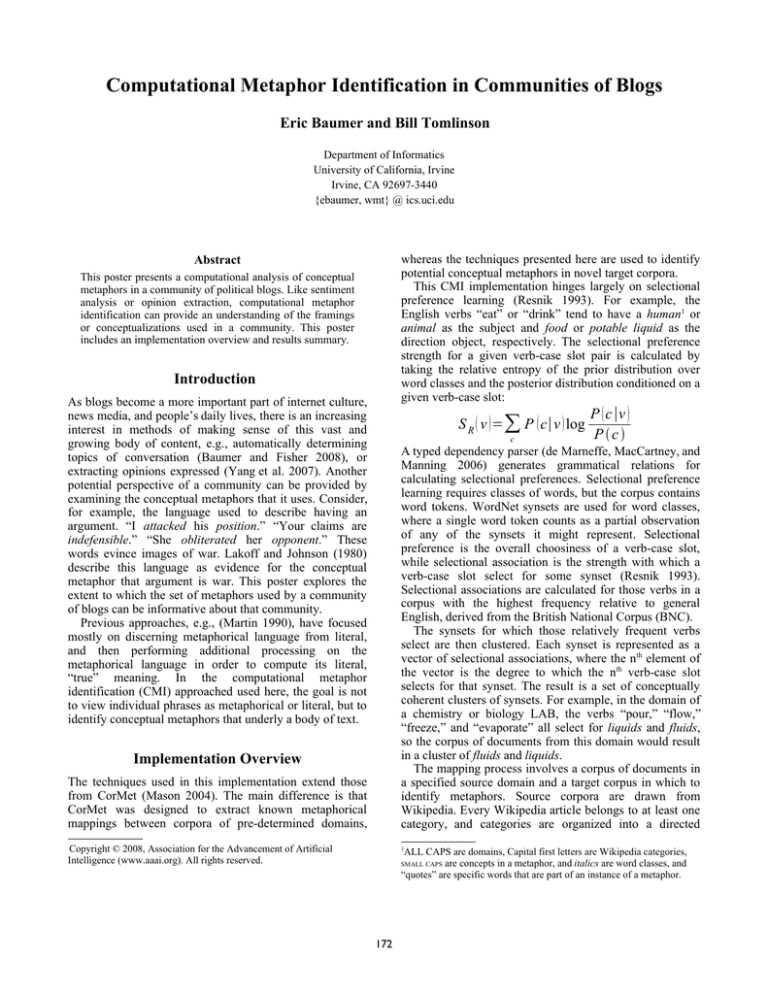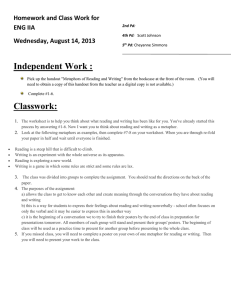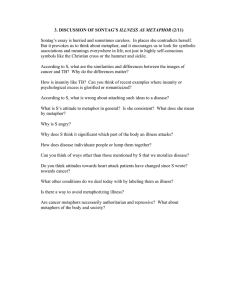
Computational Metaphor Identification in Communities of Blogs
Eric Baumer and Bill Tomlinson
Department of Informatics
University of California, Irvine
Irvine, CA 92697-3440
{ebaumer, wmt} @ ics.uci.edu
whereas the techniques presented here are used to identify
potential conceptual metaphors in novel target corpora.
This CMI implementation hinges largely on selectional
preference learning (Resnik 1993). For example, the
English verbs “eat” or “drink” tend to have a human1 or
animal as the subject and food or potable liquid as the
direction object, respectively. The selectional preference
strength for a given verb-case slot pair is calculated by
taking the relative entropy of the prior distribution over
word classes and the posterior distribution conditioned on a
given verb-case slot:
Abstract
This poster presents a computational analysis of conceptual
metaphors in a community of political blogs. Like sentiment
analysis or opinion extraction, computational metaphor
identification can provide an understanding of the framings
or conceptualizations used in a community. This poster
includes an implementation overview and results summary.
Introduction
As blogs become a more important part of internet culture,
news media, and people’s daily lives, there is an increasing
interest in methods of making sense of this vast and
growing body of content, e.g., automatically determining
topics of conversation (Baumer and Fisher 2008), or
extracting opinions expressed (Yang et al. 2007). Another
potential perspective of a community can be provided by
examining the conceptual metaphors that it uses. Consider,
for example, the language used to describe having an
argument. “I attacked his position.” “Your claims are
indefensible.” “She obliterated her opponent.” These
words evince images of war. Lakoff and Johnson (1980)
describe this language as evidence for the conceptual
metaphor that argument is war. This poster explores the
extent to which the set of metaphors used by a community
of blogs can be informative about that community.
Previous approaches, e.g., (Martin 1990), have focused
mostly on discerning metaphorical language from literal,
and then performing additional processing on the
metaphorical language in order to compute its literal,
“true” meaning. In the computational metaphor
identification (CMI) approached used here, the goal is not
to view individual phrases as metaphorical or literal, but to
identify conceptual metaphors that underly a body of text.
S R v =∑ P c∣v log
c
P c∣v
Pc
A typed dependency parser (de Marneffe, MacCartney, and
Manning 2006) generates grammatical relations for
calculating selectional preferences. Selectional preference
learning requires classes of words, but the corpus contains
word tokens. WordNet synsets are used for word classes,
where a single word token counts as a partial observation
of any of the synsets it might represent. Selectional
preference is the overall choosiness of a verb-case slot,
while selectional association is the strength with which a
verb-case slot select for some synset (Resnik 1993).
Selectional associations are calculated for those verbs in a
corpus with the highest frequency relative to general
English, derived from the British National Corpus (BNC).
The synsets for which those relatively frequent verbs
select are then clustered. Each synset is represented as a
vector of selectional associations, where the nth element of
the vector is the degree to which the nth verb-case slot
selects for that synset. The result is a set of conceptually
coherent clusters of synsets. For example, in the domain of
a chemistry or biology LAB, the verbs “pour,” “flow,”
“freeze,” and “evaporate” all select for liquids and fluids,
so the corpus of documents from this domain would result
in a cluster of fluids and liquids.
The mapping process involves a corpus of documents in
a specified source domain and a target corpus in which to
identify metaphors. Source corpora are drawn from
Wikipedia. Every Wikipedia article belongs to at least one
category, and categories are organized into a directed
Implementation Overview
The techniques used in this implementation extend those
from CorMet (Mason 2004). The main difference is that
CorMet was designed to extract known metaphorical
mappings between corpora of pre-determined domains,
Copyright © 2008, Association for the Advancement of Artificial
Intelligence (www.aaai.org). All rights reserved.
1
ALL CAPS are domains, Capital first letters are Wikipedia categories,
are concepts in a metaphor, and italics are word classes, and
“quotes” are specific words that are part of an instance of a metaphor.
SMALL CAPS
172
Metaphor
TERRORISM
Target
is an EVIL
ATTACK
TERRORISM
is an EVIL
ATTACKER
RELIGION
terrorism
terrorism
is an ATTACK religion, faith
Source
verb-case slot
Conf
Example Sentence
evil, Satan
fight - prep_against
0.104
hit, collision
protect - prep_against
0.036
war, hostility, campaign
violate - nsubj
0.002
battle, struggle, conflict
violate - nsubj
0.001
“The USA Today report...
sparked a renewed debate over
government intrusion into
Americans' civil liberties in the
fight against terrorism.”
evil, Satan
fight - prep_against
0.104
bandit, brigand
combat - dobj
0.007
intruder, stranger
violate - nsubj
0.007
intruder, stranger
violate - nsubj
0.018
war, hostility, campaign
violate - nsubj
0.013
“US... efforts to combat
terrorism.”
“His 'faith based' initiatives
violate the first [amendment].”
battle, struggle, conflict violate - nsubj
0.012
Table 1 – Metaphors and supporting mappings in the Think Progress community. The first column is the manually assigned metaphor. The
next four columns describe the computationally identified mappings supporting a metaphor: salient term(s) from the target and source
clusters, mediating verb-case slot, and confidence score. The last column is an example sentence from the corpus (emphases added).
acyclic graph. The corpus for a domain is all the Wikipedia
pages in a given category, such as Military, and all the
pages in all its subcategories, such as Military history.
Mappings are sought using selectional associations for
clusters across different corpora. The selectional
association of a verb-case slot for a cluster is the average
of that verb-case slot's selectional association for each
member of the cluster. The polarity of a mapping from
cluster x in domain A to cluster y in domain B is:
surprising, given the “war on terror” rhetoric in US politics
of the time. The metaphor RELIGION is an ATTACK also makes
sense, given that Think Progress is a liberal blog, and most
US liberals negatively view the incorporation of religion in
politics. For someone not familiar with the Think Progress
community, these metaphors provide an introduction to the
conceptual framings used in the community's discussions.
The results demonstrate that CMI can effectively identify
meaningful and informative conceptual metaphors.
∑ Λ α,y,B ∗0 .75 +Λ α,x,A ∗0 . 25
α
References
where α ranges over the verb-case slots that select for x in
A, and Λ(α, x, A) is the selectional association strength of
the verb-case slot α for cluster x in domain A. The overall
confidence for a mapping M is:
vcs M
tot_vcs
∗0 . 25
Baumer, E. and Fisher, D. 2008. Smarter Blogroll: An
Exploration of Social Topic Extraction for Manageable
Blogrolls. In Hawai'i Int'l Conf on System Sciences, IEEE
Computer Society.
pol M
∗0. 75
max_pol
Bulters, J. and de Rijke, M. 2007. Discovering Weblog
Communities: A Content- and Topology-Based Approach.
In Int'l Conf on Weblogs and Social Media, AAAI Press.
where vcs(M) is the number of verb-case slots that mediate
a given mapping, max_vcs is the total number of verb-case
slots selecting for the two clusters being mapped, pol(M) is
the polarity of the given mapping, and max_pol is the
maximum polarity of all mappings between the two
domains in question.
de Marneffe, M., MacCartney, B., and Manning, C. 2006.
Generating Typed Dependency Parses from Phrase
Structure Parses. In Language Resources and Evaluation.
Lakoff, G. and Johnson, M. 1980. Metaphors We Live By.
Chicago, IL: University of Chicago Press.
Test Evaluation
Martin, J. 1990. A Computational Model of Metaphor
Interpretation. San Diego, CA: Academic Press.
This CMI technique was applied to a community of blogs
from
the
2007
ICWSM
dataset
(http://www.icwsm.org/data.html). Starting with Think
Progress (http://thinkprogress.org), a community of blogs
was identified using (Bulters and de Rijke 2007). The
resulting community from this data set contained 23 blogs
with 1950 posts, yielding a corpus of 645,421 words.
Mapping were then sought from the MILITARY domain, a
corpus of 1867 articles containing 507,589 words.
The first two metaphors in table 1, framing TERRORISM as
an EVIL ATTACK or an EVIL ATTACKER, are not entirely
Mason, Z. 2004. CorMet: a computational, corpus-based
conventional metaphor extraction system. Computational
Linguistics 30(1): 23-44.
Resnik, P. 1993. Selection and Information: A Class-Based
Approach to Lexical Relationships. Ph.D. diss, Dept of
Comp and Info Sci, Univ of Penn., Philadelphia, PA.
Yang, K., et al. 2007. Fusion Approach to Finding
Opinions in Blogosphere. In Int'l Conf on Weblogs and
Social Media, AAAI Press.
173








